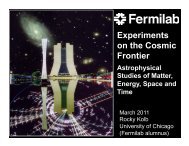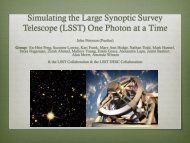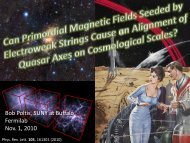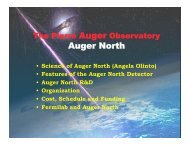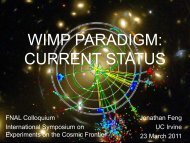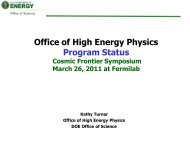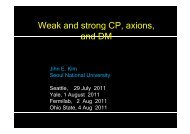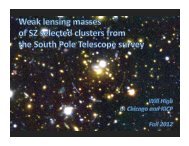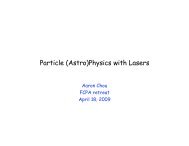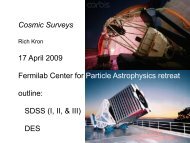Priscilla Cushman - Fermilab Center for Particle Astrophysics
Priscilla Cushman - Fermilab Center for Particle Astrophysics
Priscilla Cushman - Fermilab Center for Particle Astrophysics
Create successful ePaper yourself
Turn your PDF publications into a flip-book with our unique Google optimized e-Paper software.
Direct Dark Matter Experiments:<br />
Current Technologies and Future Directions<br />
<strong>Priscilla</strong> <strong>Cushman</strong><br />
University of Minnesota<br />
<strong>Fermilab</strong> Comic Frontier Symposium<br />
March 23-‐26, 2011<br />
FNAL Cosmic Frontier Mar 25, 2011<br />
<strong>Priscilla</strong> <strong>Cushman</strong>
(Roszkowski 2004)<br />
FNAL Cosmic Frontier Mar 25, 2011<br />
The Requisite Anti-‐Hubris Plot<br />
HUGE σ - m space<br />
Our Favorite candidate<br />
Weakly Interacting Massive <strong>Particle</strong><br />
neutralino: weak interaction scale,<br />
suppressed by mixing angles in<br />
the neutralino couplings<br />
m χ > 70 GeV from LEP<br />
> few GeV from Ω χ h 2 < 1<br />
< 300TeV from unitarity<br />
tens – 100’s GeV fine tuning arguments<br />
<strong>Priscilla</strong> <strong>Cushman</strong>
(Roszkowski 2004)<br />
FNAL Cosmic Frontier Mar 25, 2011<br />
Dark Matter Candidates<br />
L<br />
K<br />
P<br />
Kaluza-‐Klein modes<br />
LKP is also a WIMP<br />
m ~ 400 – 1200 GeV Relic Density<br />
m > 300 GeV Compactification Scale R -‐1<br />
mass splitting can be small m n = n/R<br />
coannihilation large<br />
may be difficult signature <strong>for</strong> LHC<br />
many models:<br />
UED, MUED, warped dimensions<br />
<strong>Priscilla</strong> <strong>Cushman</strong>
(Roszkowski 2004)<br />
FNAL Cosmic Frontier Mar 25, 2011<br />
Dark Matter Candidates<br />
Our NEXT Favorite candidate<br />
Axions<br />
m < 0.01 eV<br />
lab searches, stellar cooling, SN 1987A<br />
Very weak: not in thermal equilibrium with<br />
early universe.<br />
Born non-‐relativistic (cold dark matter)<br />
Thermally produced in stars<br />
strong astrophysics limits<br />
<strong>Priscilla</strong> <strong>Cushman</strong>
Region we<br />
will<br />
have probe already over the<br />
excluded next decade<br />
(Roszkowski 2004)<br />
FNAL Cosmic Frontier Mar 25, 2011<br />
L<br />
K<br />
P<br />
Most Searches<br />
concentrate on WIMPs<br />
log pb<br />
-5<br />
-8<br />
<strong>Priscilla</strong> <strong>Cushman</strong>
Kathryn Zurek’s lamp post<br />
(in a happy frame of mind)<br />
FNAL Cosmic Frontier Mar 25, 2011<br />
Low Mass Hints<br />
or The Drunkard’s Walk<br />
WIMP Miracle<br />
LHC October<br />
Surprise<br />
<strong>Priscilla</strong> <strong>Cushman</strong>
Direct Detection of WIMPs<br />
1. <strong>Particle</strong> Physics: Interaction cross section with target material<br />
WIMPs elastically scatter off nuclei in targets, producing nuclear recoils.<br />
!<br />
R " N # $N<br />
m $<br />
v esc<br />
% $<br />
vmin f (v)dv<br />
v<br />
(a) Spin-independent interaction µA 2<br />
( large λ dB è coherent interaction )<br />
(b) Spin-dependent needs target with net spin<br />
2. <strong>Astrophysics</strong>: WIMP distribution in our galaxy<br />
Isothermal, spherical halo and M-B velocity dist:<br />
v 0 ~ 230 km/s v esc ~ 550 km/s<br />
ρ χ = 0.3 GeV / cm 3<br />
FNAL Cosmic Frontier Mar 25, 2011<br />
&<br />
χ<br />
H,h,Z<br />
χ<br />
q q<br />
galactic center<br />
Sun 230 km/s<br />
χ χ<br />
q~<br />
q q<br />
June<br />
<strong>Priscilla</strong> <strong>Cushman</strong><br />
Dec.
WIMP Spectrum in a Detector<br />
Results in a Featureless Exponential Recoil spectrum<br />
Energies in the tens of keV è Need Very Sensitive Detectors<br />
Rate of < .1 evt/kg/yr è Need Very Low Background<br />
Details and Fall-off depend on Nuclear Physics of Target Material<br />
FNAL Cosmic Frontier Mar 25, 2011<br />
Recoil Energy (keV)<br />
Ar: A = 40<br />
Ge: A = 73<br />
Xe: A = 131<br />
<strong>Priscilla</strong> <strong>Cushman</strong>
Signal<br />
χ<br />
γ<br />
Choose your Technique<br />
nuclear recoil=NR<br />
v/c ~ 7 x 10 -4<br />
Count nuclear recoils annual flux variation<br />
Background<br />
electron recoil=ER<br />
v/c ~ 0.3<br />
FNAL Cosmic Frontier Mar 25, 2011<br />
β,γ discriminate between ER vs NR<br />
-or- eliminate sensitivity to ER<br />
-or- self-shielding<br />
n multiple scatters<br />
σ varies with target<br />
diurnal directional<br />
modulation<br />
go deep<br />
shielding<br />
α much higher energy deposit.<br />
problem <strong>for</strong> threshold devices, trackers<br />
<strong>Priscilla</strong> <strong>Cushman</strong>
Avoiding Neutrons: Worldwide Underground Labs<br />
with Dark Matter Experiments<br />
San<strong>for</strong>d<br />
(4100)<br />
WIPP<br />
(1600)<br />
Aqua Negra<br />
(4500)<br />
SNOLab<br />
(6000)<br />
Soudan<br />
(2100)<br />
FNAL Cosmic Frontier Mar 25, 2011<br />
Boulby<br />
(2800)<br />
Canfranc<br />
(2450)<br />
Modane<br />
(4800)<br />
LNGS<br />
(3600)<br />
IceCube<br />
(2450)<br />
JinPing<br />
(7500)<br />
Yangyang<br />
(2100)<br />
<strong>Priscilla</strong> <strong>Cushman</strong><br />
Kamioka<br />
(2700)
Avoiding Neutrons<br />
(poorly understood processes)<br />
YangYang<br />
IceCube<br />
FNAL Cosmic Frontier Mar 25, 2011<br />
Canfranc<br />
~ 200 GeV<br />
~ 250 GeV<br />
San<strong>for</strong>d<br />
Andes<br />
~ 350 GeV<br />
DUSEL 7400 level CJPL<br />
neutron flux<br />
E n > 10 MeV<br />
6 x 10 -9 cm -2 s -1<br />
trackers, mod exp.<br />
neutron veto<br />
MC benchmarking<br />
1 x 10 -9 cm -2 s -1<br />
water shields<br />
muon veto<br />
1 x 10 -11 cm -2 s -1<br />
relaxed shielding<br />
but ?<br />
penetrating n’s<br />
high multiplicity evts<br />
<strong>Priscilla</strong> <strong>Cushman</strong>
Removing Electromagnetic Backgrounds<br />
FNAL Cosmic Frontier Mar 25, 2011<br />
M. Attisha<br />
Exploit media with a<br />
different response to<br />
NR: Nuclear Recoils<br />
and<br />
ER: Electron Recoils<br />
to distinguish between<br />
WIMPs and background<br />
Two-channel strategy:<br />
One signal with NR/ER < 1<br />
Another to normalize<br />
energy scale<br />
<strong>Priscilla</strong> <strong>Cushman</strong>
Counting Nuclear Recoils: Types of Signals<br />
heat, vibration<br />
light charge<br />
NaI, CsI, CaWO 4<br />
Liquid Ar, Xe<br />
high pressure Xe<br />
FNAL Cosmic Frontier Mar 25, 2011<br />
Germanium, Silicon<br />
CaWO 4 , sapphire<br />
Germanium, Silicon<br />
Liquid Ne, Ar, Xe<br />
Gas: Ne, Xe, Ar,<br />
C 2 H 6 , CF 4 etc…<br />
<strong>Priscilla</strong> <strong>Cushman</strong>
Counting Nuclear Recoils: Experiments<br />
two signals are better than one<br />
scintillation<br />
KIMS, ANAIS, Tokyo<br />
NAIAD, DAMA<br />
CLEAN, DEAP<br />
Zeplin I, XMASS<br />
FNAL Cosmic Frontier Mar 25, 2011<br />
phonon, bolometric<br />
ROSEBUD<br />
CRESST II<br />
COUPP, Picasso, SIMPLE<br />
CRESST I<br />
EURECA<br />
WARP, ArDM<br />
Xenon-10, 100<br />
ZEPLIN II, III<br />
Darkside<br />
Panda-X<br />
LUX<br />
CDMS<br />
Edelweiss<br />
ionization<br />
HDMS,<br />
GENIUS, IGEX,<br />
CoGeNT, TEXONO<br />
<strong>Priscilla</strong> <strong>Cushman</strong>
Cryogenic Techniques at mK Temperatures<br />
Need sensitivity (big ΔT) <strong>for</strong> small ΔE, so run at T
Cryogenic Techniques at mK: the other channel<br />
+ Ionization + Scintillation<br />
CDMS II (Soudan) EDELWEISS (Modane) CRESST II (Gran Sasso)<br />
charge + guard ring<br />
Al electrodes + FETs<br />
Ge (250g) or<br />
Si (100g)<br />
FNAL Cosmic Frontier Mar 25, 2011<br />
charge + guard ring<br />
Al electrodes + FETs<br />
NTD<br />
Ge<br />
(320g)<br />
SQUID<br />
Array<br />
light from CaWO 4 via<br />
sapphire-silicon sensor<br />
W-TES on Al 2 O 3 + SQUIDs<br />
Al 2 O 3<br />
CaWO 4<br />
300g<br />
<strong>Priscilla</strong> <strong>Cushman</strong>
Cryogenic Techniques at mK: the other channel<br />
+ Ionization + Scintillation<br />
CDMS II (Soudan) EDELWEISS (Modane) CRESST II (Gran Sasso)<br />
Charge to Phonon ratio<br />
NR Quenched by factor ~ 3<br />
FNAL Cosmic Frontier Mar 25, 2011<br />
Data from radioactive source calibration<br />
Charge to Heat ratio<br />
Light to Phonon ratio<br />
Q(O) ~ 9 ER/NR from CaO<br />
Q(W) ~ 40 è insensitive to n<br />
but big A 2 effect <strong>for</strong> WIMPs<br />
<strong>Priscilla</strong> <strong>Cushman</strong>
Cryogenic Techniques at mK: Surface Events<br />
CDMS II (Soudan) EDELWEISS (Modane) CRESST II (Gran Sasso)<br />
Ionization to Phonon ratio<br />
Ionization to Heat ratio<br />
Incomplete charge collection <strong>for</strong> low energy β<br />
Ionization ratio droops into NR band<br />
FNAL Cosmic Frontier Mar 25, 2011<br />
Data from radioactive source calibration<br />
Light to Phonon ratio<br />
<strong>Priscilla</strong> <strong>Cushman</strong>
)<br />
CDMS II<br />
phonon pulse shape<br />
gives another handle<br />
Rejecting Surface Events: Timing<br />
Phonons created near surface travel<br />
faster through crystal (ballistic)<br />
FNAL Cosmic Frontier Mar 25, 2011<br />
Data from WIMP Search<br />
Timing Parameter<br />
linear combination of risetime and delay<br />
<strong>Priscilla</strong> <strong>Cushman</strong>
Rejecting Surface Events: Interleaved Electrodes<br />
Charge near surface is collected by electrodes on only one side<br />
EDELWEISS II SuperCDMS Soudan<br />
‘a’ electrodes (+4V)<br />
collecting ‘b’ electrodes (-1.5V)<br />
field shapping<br />
‘c’ (-4V) ‘d’ (+1.5V)<br />
FNAL Cosmic Frontier Mar 25, 2011<br />
fiducial<br />
volume<br />
<strong>Priscilla</strong> <strong>Cushman</strong>
Cryogenic Techniques at mK: Improved Detectors<br />
SuperCDMS (Soudan)<br />
Improved Surface Event rejections via Larger Detectors<br />
New interleaved electrodes è surface event rejection<br />
Ge (640g)<br />
phonon and charge<br />
on both sides<br />
FNAL Cosmic Frontier Mar 25, 2011<br />
EDELWEISS II (Modane) CRESST II (Gran Sasso)<br />
Ge (400g and 800g)<br />
2 NTD, 6 electrodes<br />
new cryostat – up to 40 kg<br />
More mass & multiple targets<br />
Composite detector design<br />
(simplified TES)<br />
Improve clamps to reduce bkgd<br />
mechanical (dark evts)<br />
scint veto ( 210 Pb α,NR)<br />
<strong>Priscilla</strong> <strong>Cushman</strong>
Underground Labs with Cryogenic Solid State<br />
SuperCDMS<br />
FNAL Cosmic Frontier Mar 25, 2011<br />
Edelweiss<br />
CRESST<br />
<strong>Priscilla</strong> <strong>Cushman</strong>
Snapshot: All three have unexplained<br />
backgrounds … WIMP hint?<br />
CDMS II<br />
Blind analysis gave 2 evts<br />
bkgd of 0.8 ± 0.1(stat) ± 0.2(sys)<br />
23% probability to observe ≥ 2 evts<br />
FNAL Cosmic Frontier Mar 25, 2011<br />
EDELWEISS II (interleaved)<br />
Blind analysis gave 5 evts<br />
bkgd studies still proceeding<br />
Expected < 3 evts<br />
<strong>Priscilla</strong> <strong>Cushman</strong>
FNAL Cosmic Frontier Mar 25, 2011<br />
Snapshot: All three have unexplained<br />
backgrounds … Set Limits<br />
<strong>Priscilla</strong> <strong>Cushman</strong>
Snapshot: All three have unexplained<br />
backgrounds … WIMP hint?<br />
one crystal out of 9<br />
signal<br />
FNAL Cosmic Frontier Mar 25, 2011<br />
CRESST II oxygen events<br />
210 Pb on crystal, clamps<br />
M W = 12 GeV/c 2 @ 5.4 σ<br />
564 kg-d from 9 CaWO 4 crystals<br />
<strong>Priscilla</strong> <strong>Cushman</strong>
Main issues are<br />
Complexity and Scaling up<br />
Material cost (e.g. Ge $20/g)<br />
Cryogenic demands<br />
Challenges <strong>for</strong> Cryogenic Phonon<br />
For new Ge detectors, bkgd challenge largely met!<br />
Surface contamination (betas) è Fiducial cut using<br />
Phonon timing<br />
Interleaved electrodes<br />
should be good enough <strong>for</strong> ton scale experiment<br />
CRESST II More exposure (more neutron multiples to benchmark)<br />
Reduce alphas (contamination and clamps)<br />
Improve light collection and lower threshold<br />
FNAL Cosmic Frontier Mar 25, 2011<br />
<strong>Priscilla</strong> <strong>Cushman</strong>
Counting Nuclear Recoils: Experiments<br />
two signals are better than one<br />
scintillation<br />
KIMS, ANAIS, Tokyo<br />
NAIAD, DAMA<br />
CLEAN, DEAP<br />
Zeplin I, XMASS<br />
FNAL Cosmic Frontier Mar 25, 2011<br />
phonon, bolometric<br />
ROSEBUD<br />
CRESST II<br />
COUPP, Picasso, SIMPLE<br />
CRESST I<br />
EURECA<br />
WARP, ArDM<br />
Xenon-10, 100<br />
ZEPLIN II, III<br />
Darkside<br />
Panda-X<br />
LUX<br />
CDMS<br />
Edelweiss<br />
ionization<br />
HDMS,<br />
GENIUS, IGEX,<br />
CoGeNT, TEXONO<br />
<strong>Priscilla</strong> <strong>Cushman</strong>
Ionization + Scintillation: Two-Phase Noble Liquids<br />
FNAL Cosmic Frontier Mar 25, 2011<br />
Time Projection Chamber technology<br />
60 Co and 241 AmBe calibration data<br />
ER<br />
NR<br />
XENON100: Aprile et al. arXiv:1005.0380v3<br />
<strong>Priscilla</strong> <strong>Cushman</strong>
Ionization + Scintillation: Two-Phase Noble Liquids<br />
FNAL Cosmic Frontier Mar 25, 2011<br />
Choose your working fluid<br />
Argon Xenon<br />
A = 40 A = 131, <strong>for</strong>m factor<br />
reduction at higher E r<br />
λ = 128 nm (λ-shifter) λ = 125 nm (UV PMT)<br />
$2/kg $800/kg<br />
100% even-even nuclei 50% odd-n nuclei<br />
39 Ar (1Bq/kg in Nat Ar)<br />
new sources from wells<br />
85 Kr (removed via<br />
filter or distillation)<br />
<strong>Priscilla</strong> <strong>Cushman</strong>
Ionization + Scintillation: Two-Phase Noble Liquids<br />
Lots of experiments !<br />
Liq Xenon Location Tot (Fid) kg<br />
Xenon10 LNGS 15 (5.4) finished<br />
Xenon100 LNGS 170 (65) running<br />
Zeplin II Boulby 31 (7.2) finished<br />
Zeplin III Boulby 12 (6.5) running<br />
LUX San<strong>for</strong>d 300 (100) testing<br />
Panda-X JinPing 120 (25) testing<br />
Liq. Argon Location Tot (Fid) kg<br />
WArP LNGS 3.2 finished<br />
WArP LNGS 8T (140) running<br />
ArDM CERN/Canfranc 850 kg testing<br />
Darkside LNGS 50 kg prototype testing<br />
FNAL Cosmic Frontier Mar 25, 2011<br />
<strong>Priscilla</strong> <strong>Cushman</strong>
Snapshot: XENON100 poised to<br />
reject (confirm) WIMP hints<br />
Dotted: Limits with 2 L eff choices<br />
Solid: New likelihood analysis (v esc , L eff )<br />
90% CL<br />
FNAL Cosmic Frontier Mar 25, 2011<br />
arXiv:1103.0303<br />
0 candidates in Xenon100 (11d)<br />
Expect x 10 more exposure<br />
revealed in a few weeks?<br />
<strong>Priscilla</strong> <strong>Cushman</strong>
Results from the others expected<br />
in the next couple years<br />
WArP-140 is currently running<br />
ZEPLIN III final run will end this spring<br />
~1500 kg-d with neutron veto<br />
new PMTs (18x bkgd reduction)<br />
LUX surface testing now<br />
Underground Spring 2012<br />
Large water tank<br />
FNAL Cosmic Frontier Mar 25, 2011<br />
Panda-X<br />
complete by Fall 2011<br />
Deep! no active shield<br />
ZEPLIN III (2008)<br />
<strong>Priscilla</strong> <strong>Cushman</strong>
scintillation<br />
KIMS, ANAIS, Tokyo<br />
NAIAD, DAMA<br />
CLEAN, DEAP<br />
Zeplin I, XMASS<br />
FNAL Cosmic Frontier Mar 25, 2011<br />
Counting Nuclear Recoils:<br />
Sometimes one mode is enough<br />
phonon, bolometric<br />
ROSEBUD<br />
CRESST II<br />
COUPP, Picasso, SIMPLE<br />
CRESST I<br />
EURECA<br />
WARP, ArDM<br />
Xenon-10, 100<br />
ZEPLIN II, III<br />
Darkside<br />
Panda-X<br />
LUX<br />
CDMS<br />
Edelweiss<br />
ionization<br />
HDMS,<br />
GENIUS, IGEX,<br />
CoGeNT, TEXONO<br />
<strong>Priscilla</strong> <strong>Cushman</strong>
Scintillation: Single Phase Noble Liquids<br />
Liquid Xenon: Large self-shielded mass, remove all contaminants, fiducial cuts<br />
54 2-inch PMTs<br />
XMASS (Kamioka)<br />
100 kg prototype è 800 kg<br />
Liquid Argon: Exploit pulse-shape discrimination against ER<br />
DEAP/CLEAN (SNOLab)<br />
FNAL Cosmic Frontier Mar 25, 2011<br />
MgF 2 window<br />
Liq. Xe<br />
(31cm) 3<br />
ratio of fast (6ns) to slow (1.6us)<br />
scint. components is larger <strong>for</strong> NR<br />
miniCLEAN<br />
DEAP-3600<br />
<strong>Priscilla</strong> <strong>Cushman</strong>
DEAP/CLEAN<br />
Snapshot: Single Phase Noble Liquids<br />
R&D microCLEAN (4 kg) LAr/LNe scintillation, PSD, NR quenching<br />
DEAP-1 (7 kg) PSD rejection of 4.7 x 10 -8 <strong>for</strong> 25-86 keV ee<br />
WIMP search starts 2012<br />
MiniCLEAN (500 kg) LAr/LNe to ~ 10 -45 cm 2<br />
Max light collection/sensitivity (> 6 pe/keV)<br />
DEAP-3600 (3600 kg) LAr/DAr to ~ 10 -46 cm 2<br />
eventually<br />
CLEAN 10-100 Tons ~ 2 x 10 -47 cm 2<br />
FNAL Cosmic Frontier Mar 25, 2011<br />
XMASS has extraordinary purity and lowrad PMTs<br />
100 kg is running now, 800 kg expected in 2012<br />
<strong>Priscilla</strong> <strong>Cushman</strong>
Challenges <strong>for</strong> Noble Liquids<br />
Argon: 39 Ar (1 Bq/kg) in atmospheric argon<br />
Depleted argon underground sources (x20)<br />
Good PSD against β-decay<br />
Xenon: 85 Kr cryo distillation to < 50 ppt (Xenon100 goal)<br />
XMASS at 3 ppt 85 Kr (mass spec), U/Th 10 -13 g/g<br />
Backgrounds<br />
Gammas reduced by self-shielding (less reliance on ER:NR)<br />
PMT neutrons: New lowrad H8778, APDPMTs (e.g. QUPIDs)<br />
Wire readout (LEMS in ArDM)<br />
Surfaces: Fiducial cuts<br />
Single phase: Max light collection in 4π<br />
Dual phase: drift time discrimination<br />
Scaling up<br />
Cryogenics less demanding than bolometers<br />
Single phase much easier than dual<br />
FNAL Cosmic Frontier Mar 25, 2011<br />
WArP is triple<br />
discrimination<br />
(like CDMS)<br />
<strong>Priscilla</strong> <strong>Cushman</strong>
LUX<br />
Underground Labs with Noble Liquid DM<br />
DEAP<br />
CLEAN<br />
FNAL Cosmic Frontier Mar 25, 2011<br />
2-phase<br />
1-phase<br />
ZEPLIN III<br />
ArDM<br />
Xenon 100<br />
Darkside<br />
WArP<br />
xenon<br />
argon<br />
PandaX<br />
XMASS<br />
<strong>Priscilla</strong> <strong>Cushman</strong>
scintillation<br />
KIMS, ANAIS, Tokyo<br />
NAIAD, DAMA<br />
CLEAN, DEAP<br />
Zeplin I, XMASS<br />
FNAL Cosmic Frontier Mar 25, 2011<br />
Counting Nuclear Recoils:<br />
Sometimes one mode is enough<br />
phonon, bolometric<br />
ROSEBUD<br />
CRESST II<br />
COUPP, Picasso, SIMPLE<br />
CRESST I<br />
EURECA<br />
WARP, ArDM<br />
Xenon-10, 100<br />
ZEPLIN II, III<br />
Darkside<br />
Panda-X<br />
LUX<br />
CDMS<br />
Edelweiss<br />
ionization<br />
HDMS,<br />
GENIUS, IGEX,<br />
CoGeNT, TEXONO<br />
<strong>Priscilla</strong> <strong>Cushman</strong>
High Purity Germanium<br />
* Excellent energy resolution<br />
* Mostly used <strong>for</strong> neutrino experiments<br />
* Also can do neutrinoless double beta decay detectors<br />
Use energy resolution<br />
to beat down background<br />
No evt by evt ER vs NR discrimination<br />
Some pulse shape discrimination<br />
FNAL Cosmic Frontier Mar 25, 2011<br />
<strong>Priscilla</strong> <strong>Cushman</strong>
High Purity Germanium<br />
* Excellent energy resolution<br />
* Mostly used <strong>for</strong> neutrino experiments<br />
* Also can do neutrinoless double beta decay detectors<br />
Use energy resolution<br />
to beat down background<br />
No evt by evt ER vs NR discrimination<br />
Some pulse shape discrimination<br />
Window of opportunity: can go to<br />
very low thresholds with new<br />
low capacitance configurations<br />
FNAL Cosmic Frontier Mar 25, 2011<br />
<strong>Priscilla</strong> <strong>Cushman</strong>
Underground Labs with low threshold HPGe<br />
CoGeNT<br />
FNAL Cosmic Frontier Mar 25, 2011<br />
CDEX<br />
TEXONO<br />
<strong>Priscilla</strong> <strong>Cushman</strong><br />
KIMS
SONGS<br />
Soudan<br />
FNAL Cosmic Frontier Mar 25, 2011<br />
High Purity Germanium: CoGeNT<br />
Continue to develop the P-type point contact HPGe<br />
ββ0ν (Majorana)<br />
ν detector<br />
DM detector<br />
Aalseth et al., arXiv:1002.4703<br />
<strong>Priscilla</strong> <strong>Cushman</strong>
High Purity Germanium: CDEX/TEXONO<br />
CDEX (China Dark matter EXperiment) at new Jin-Ping Lab<br />
Merging of collaborations and technologies<br />
TEXONO (Taiwan EXperiment On neutrinO) at Kuo Sheng Reactor<br />
ULB-HPGe (1 kg)<br />
CsI(Tl) (200 kg)<br />
ULE-ULB-HPGe (20g)<br />
DM search moves to JinPing (China, India, Turkey, TEXONO, KIMS)<br />
4 x 5g ULEGe 500g and 900g PCGe detector<br />
FNAL Cosmic Frontier Mar 25, 2011<br />
Ethr (50% eff) 200-300 eV.<br />
Eventual exposure up to 100 kg-d<br />
<strong>Priscilla</strong> <strong>Cushman</strong>
CoGeNT sees<br />
exponential<br />
excess at low<br />
energies<br />
So does TEXONO è not yet ready<br />
to do DM run at newer deeper site<br />
FNAL Cosmic Frontier Mar 25, 2011<br />
Snapshot: improved HPGe technology<br />
<strong>Priscilla</strong> <strong>Cushman</strong>
New Kids on the Block<br />
China Jin-Ping Underground Laboratory<br />
(CJPL)<br />
DAMIC<br />
FNAL Cosmic Frontier Mar 25, 2011<br />
Low threshold<br />
HPGe Lab<br />
LBNL full depletion CCD (DECam)<br />
high resistivity silicon tracker<br />
1 g/CCD @ 0.036 keVee thresh<br />
Dual phase<br />
LXe TPC Lab<br />
<strong>Priscilla</strong> <strong>Cushman</strong>
Why all the excitement?<br />
Low mass WIMPs promise DAMA compatibility<br />
Manzur et al. arXiv:0909.1063<br />
XENON10<br />
FNAL Cosmic Frontier Mar 25, 2011<br />
ZEPLIN-III<br />
Low energies more vulnerable to<br />
Uncertainties in astrophysics<br />
Uncertainties in L eff<br />
Uncertainties in Energy Scale<br />
Co-rotating disk<br />
Bruch et al. arXiv:0804.2896<br />
<strong>Priscilla</strong> <strong>Cushman</strong>
New CDMS & XENON low energy threshold<br />
analyses make it less likely<br />
Relaxing the NR discrimination<br />
CDMS gives up ionization signal<br />
(except <strong>for</strong> “drift heating” correction)<br />
FNAL Cosmic Frontier Mar 25, 2011<br />
CDMS Ge<br />
low thresh<br />
const L eff<br />
XENON gives up prompt scint (S1)<br />
fiducial cuts via S2 width<br />
lower L eff<br />
<strong>Priscilla</strong> <strong>Cushman</strong>
New CDMS & XENON limits make it less likely<br />
FNAL Cosmic Frontier Mar 25, 2011<br />
Relaxing the NR discrimination<br />
CDMS Ge<br />
low thresh<br />
const L eff<br />
lower L eff<br />
<strong>Priscilla</strong> <strong>Cushman</strong>
scintillation<br />
KIMS, ANAIS, Tokyo<br />
NAIAD, DAMA<br />
CLEAN, DEAP<br />
Zeplin I, XMASS<br />
FNAL Cosmic Frontier Mar 25, 2011<br />
Counting Nuclear Recoils:<br />
Sometimes one mode is enough<br />
phonon, bolometric<br />
ROSEBUD<br />
CRESST II<br />
COUPP, Picasso, SIMPLE<br />
CRESST I<br />
EURECA<br />
WARP, ArDM<br />
Xenon-10, 100<br />
ZEPLIN II, III<br />
Darkside<br />
Panda-X<br />
LUX<br />
CDMS<br />
Edelweiss<br />
ionization<br />
HDMS,<br />
GENIUS, IGEX,<br />
CoGeNT, TEXONO<br />
<strong>Priscilla</strong> <strong>Cushman</strong>
Threshold Detectors: Insensitive to ER altogether!<br />
Nucleation Threshold determined by T, P è insensitivity to γ, β<br />
Fill with a flurocarbon: Emphasis on spin-dependent limits via 19 F<br />
Neutron dosimeter technology Bubble Chamber<br />
SIMPLE (Bas Bruit)<br />
1-4 % suspension of<br />
superheated C 2 ClF 5<br />
droplets in gel.<br />
shielded pool, shallow<br />
FNAL Cosmic Frontier Mar 25, 2011<br />
PICASSO (SNOLab)<br />
0.5% C 4 F 10 droplets<br />
in water-based gel<br />
piezoelectric transducers<br />
MIP Multiple NR Single NR<br />
COUPP (SNOLab)<br />
Superheated bubble chamber<br />
CF 3 I, multiple targets<br />
CCD camera (+ acoustic)<br />
<strong>Priscilla</strong> <strong>Cushman</strong>
Scattering Cross Sections<br />
Spin Independent vs Spin Dependent<br />
In general, a Lorentz invariant Lagrangian L has S, P, V, A interactions.<br />
The WIMPs can be a fermion or a boson or a scalar particle<br />
However, galactic WIMPs are non-relativistic è divide into two categories<br />
(a) L S+V : Scalar interaction as µA 2<br />
( large λ dB è coherent interaction )<br />
(b) L A Spin-spin interaction couples<br />
to net nuclear spin J N<br />
FNAL Cosmic Frontier Mar 25, 2011<br />
f and a are effective<br />
couplings and <br />
gives the spin content<br />
χ χ<br />
p p<br />
f p or a p <br />
<strong>Priscilla</strong> <strong>Cushman</strong>
SIMPLE pulls ahead<br />
x10 reduction in acoustic noise<br />
piezoelectric transducer è high-quality electret microphone<br />
and adaptive electronics.<br />
New SD limits (14.1 kg-d ) using<br />
15 superheated droplet detectors with total active mass of 0.208 kg.<br />
| a p | < 0.32, |a n | < 0.17 <strong>for</strong> 50 GeV/c 2 WIMP<br />
FNAL Cosmic Frontier Mar 25, 2011<br />
needs Xenon10<br />
to achieve this.<br />
<strong>Priscilla</strong> <strong>Cushman</strong>
COUPP & PICASSO right behind<br />
new installations with water shields at SNOLab<br />
COUPP 4 kg CF 3 I chamber moved from FNAL<br />
Stable running @ 79% livetime since Nov 2010<br />
>98% acoustic α rejection<br />
….. stay tuned!<br />
COUPP 60 kg bubble chamber<br />
undergoing tests.<br />
Running in NUMI (FNAL)<br />
FNAL Cosmic Frontier Mar 25, 2011<br />
PICASSO: 32 detector modules<br />
with an active mass of 2.6 kg<br />
Extensive bubble <strong>for</strong>mation &<br />
acoustic discrimination studies<br />
COUPP 4-Kg Chamber (2011)<br />
Neutrons<br />
2% spillover<br />
from alpha to<br />
neutron<br />
region<br />
Alphas<br />
<strong>Priscilla</strong> <strong>Cushman</strong>
Challenges <strong>for</strong> Threshold Detectors<br />
Backgrounds: alphas and neutrons<br />
Alphas from materials and radon plateout on vessels<br />
Make a Fiducial cut: spatial localization<br />
arrays of microphones or CCD cameras<br />
Improving α:n discrimination<br />
SIMPLE: α bkgd < 0.5 evt/kg/d.<br />
U/Th contaminations in the gel, measured at ~ 0.1 ppb<br />
COUPP α bkgd ~5.3 evt/kg/d ( 222 Rn from leaky valve? can be reduced)<br />
1 n/day from 8 piezoelectric transducers (replace this summer)<br />
Scaling up<br />
Bubble chambers can deploy larger masses more easily than SDD<br />
But who will win the acoustic discrimination contest?<br />
FNAL Cosmic Frontier Mar 25, 2011<br />
<strong>Priscilla</strong> <strong>Cushman</strong>
Signal<br />
χ<br />
γ<br />
Choose your Technique<br />
nuclear recoil=NR<br />
v/c ~ 7 x 10 -4<br />
Count nuclear recoils annual flux variation<br />
Background<br />
electron recoil=ER<br />
v/c ~ 0.3<br />
β,γ discriminate between ER vs NR<br />
-or- eliminate sensitivity to ER<br />
-or- self-shielding<br />
n multiple scatters<br />
σ varies with target<br />
diurnal directional<br />
modulation<br />
Doesn’t require event by event background rejection,<br />
go deep<br />
shielding<br />
but WITHOUT it, detailed systematics studies required<br />
FNAL Cosmic Frontier Mar 25, 2011<br />
α much higher energy deposit.<br />
problem <strong>for</strong> threshold devices, trackers<br />
<strong>Priscilla</strong> <strong>Cushman</strong>
Diurnal Directional Modulation<br />
Robust Signature – Promises WIMP astronomy!<br />
large modulation (20-50%), rather than 3% <strong>for</strong> annual<br />
sidereal – hard to fake it with bkgd<br />
To see tracks or head-tail difference è gas target<br />
But gas targets need to be big (compared to solid)<br />
DRIFT II (running – Boulby)<br />
Competitive SD limits<br />
Negative ion TPC w/ MWPC readout<br />
CS 2 molecule (less diffusion)<br />
NEWAGE (test cell at Kamioka)<br />
Ar + C 2 H 6 micro-TPC<br />
microdot charge readout<br />
MIMAC (test chamber CEA- Saclay)<br />
3 He or CF 4 micro-TPC<br />
DMTPC (test chamber – MIT, WIPP)<br />
CF 4 low pressure TPC with optical readout<br />
FNAL Cosmic Frontier Mar 25, 2011<br />
DRIFT<br />
DMTPC head-tail<br />
<strong>Priscilla</strong> <strong>Cushman</strong>
FNAL Cosmic Frontier Mar 25, 2011<br />
Snapshot:<br />
SD Limits and Diurnal Mod. Hopes<br />
<strong>Priscilla</strong> <strong>Cushman</strong>
Coherent neutrino Thescattering Ultimate Background<br />
limits<br />
Solar ν<br />
atmospheric<br />
100 GeV WIMP<br />
1E-47 cm 2<br />
1E-48 cm 2<br />
diffuse SN<br />
Strigari arXiv:0903.3630<br />
FNAL Cosmic Frontier Mar 25, 2011<br />
The Ultimate Limit in<strong>for</strong>ms<br />
technology choices<br />
Reduced sensitivity to<br />
low mass WIMPs<br />
Or call it a solar neutrino experiment<br />
Directionality and<br />
Modulation will become<br />
our only handles<br />
<strong>Priscilla</strong> <strong>Cushman</strong>
Annual Flux Variation<br />
DAMA/LIBRA exposure = 1.17 ton-years of NaI(Tl) at LNGS<br />
25 crystals, each 9.5 kg, running <strong>for</strong> 6 y in LIBRA (13 yrs total)<br />
Amplitude of a few percent Phase Max on June 2 Significance of 8.9 σ<br />
FNAL Cosmic Frontier Mar 25, 2011<br />
<strong>Priscilla</strong> <strong>Cushman</strong>
FNAL Cosmic Frontier Mar 25, 2011<br />
Annual Flux Variation<br />
integrated spectrum<br />
of single hits<br />
modulation amplitude is only<br />
significant at low energy<br />
<strong>Priscilla</strong> <strong>Cushman</strong>
Finally, a worldwide ef<strong>for</strong>t to check DAMA<br />
Borexino (Gran Sasso)<br />
NaI crystals surrounded<br />
by ultra-clean LS<br />
Same Lab<br />
Study backgrounds<br />
Requires crystals purities < 1 ct/keV/day<br />
St Gobain has exclusive contract with DAMA<br />
New R&D on NaI purity w/ St Gobain<br />
DM-Ice (South Pole)<br />
250 kg NaI<br />
Different Systematics<br />
and environ.<br />
ANAIS (Canfranc)<br />
250 kg NaI inside<br />
lead/poly shield<br />
DAMA-size array in<br />
Different Lab<br />
If DAMA signal is astrophysicalè a 5-sigma measurement in 2 years<br />
with 250 kg and comparable background to DAMA.<br />
FNAL Cosmic Frontier Mar 25, 2011<br />
<strong>Priscilla</strong> <strong>Cushman</strong>
Different Crystal<br />
But Wait! There’s More!<br />
KIMS (Yangyang Lab, Korea)<br />
Published 2007 Limit<br />
four 8.7 kg CsI(Tl) crystals <strong>for</strong> 3409 kg-d<br />
pulse shape discrimination<br />
liquid scint veto, 1 dru bkgd<br />
Reduce 137Cs in processing (water)<br />
Reduce 87Rb via repeated recrystallization<br />
Everyone can look, but it requires a low threshold<br />
(if DAMA is being checked)<br />
2009<br />
2007<br />
(100kg)<br />
2005<br />
Expect results soon from Xenon-100, CDMS<br />
Requires relaxation of ER:NR discrimination<br />
Background subtraction may be useful<br />
If higher mass WIMP, then signal itself can be observed modulating.<br />
FNAL Cosmic Frontier Mar 25, 2011<br />
<strong>Priscilla</strong> <strong>Cushman</strong>
But Wait! There’s More!<br />
Cogent C4 at Soudan. Four 0.9 kg detectors, with an estimated combined<br />
fiducial mass of 2.5 kg will not only be capable of detecting the presence of a<br />
modulation, but will be sensitive to the energy spectrum of the 2009 modulation<br />
1 year of<br />
running<br />
FNAL Cosmic Frontier Mar 25, 2011<br />
0.33 kg<br />
2.5 kg<br />
2007<br />
(100kg)<br />
2005<br />
<strong>Priscilla</strong> <strong>Cushman</strong>
Concentrating on Annual Modulation Reach<br />
scintillation<br />
KIMS, ANAIS, Tokyo<br />
NAIAD, DAMA<br />
CLEAN, DEAP<br />
Zeplin I, XMASS<br />
FNAL Cosmic Frontier Mar 25, 2011<br />
phonon, bolometric<br />
ROSEBUD<br />
CRESST II<br />
COUPP, Picasso, SIMPLE<br />
CRESST I<br />
EURECA<br />
WARP, ArDM<br />
Xenon-10, 100<br />
ZEPLIN II, III<br />
Darkside<br />
Panda-X<br />
LUX<br />
CDMS<br />
Edelweiss<br />
ionization<br />
HDMS,<br />
GENIUS, IGEX,<br />
CoGeNT, TEXONO<br />
<strong>Priscilla</strong> <strong>Cushman</strong>
Technology depends on type of axions<br />
Can be produced by<br />
Sun<br />
Axion helioscopes: Kyoto, CAST<br />
Bragg Scatter enhancement : Crystals<br />
SOLAX, COSME, DAMA, CDMS<br />
Big Bang relics<br />
Axion Haloscopes: ADMX, CARRACK<br />
Laboratory<br />
Laser production<br />
Vacuum birefringence<br />
PVLAS, ALPS, OSQAR, BMV<br />
FNAL Cosmic Frontier Mar 25, 2011<br />
<strong>Priscilla</strong> <strong>Cushman</strong>
Axion Searches do NOT need underground lab<br />
or ultrapure materials or massive collaborations<br />
So why do we care?<br />
Shared collaborators (interested in same physics)<br />
Some experiments & techniques can do double duty<br />
Solar axions via Bragg Scatter Relics: Low energy ER data can<br />
works <strong>for</strong> crystals with known orientation limit axio-electric coupling g aee<br />
upper limits on g aγγ<br />
CDMS, GERDA, solid xenon,NaI limits by CDSM, CoGeNT<br />
Its presence (subdominant?) will count toward Ω DM<br />
FNAL Cosmic Frontier Mar 25, 2011<br />
<strong>Priscilla</strong> <strong>Cushman</strong>
Axion Searches do NOT need underground lab<br />
or ultrapure materials or massive collaborations<br />
Axion Mass range: either meV-10 meV or 3 eV- 20 eV<br />
Solar<br />
FNAL Cosmic Frontier Mar 25, 2011<br />
axion-like particles (ALPs)<br />
Aalseth arXiv:1002.4703v<br />
<strong>Priscilla</strong> <strong>Cushman</strong>
FNAL Cosmic Frontier Mar 25, 2011<br />
The Future<br />
<strong>Priscilla</strong> <strong>Cushman</strong>
Shared technologies despite competition<br />
New low radioactivity PMTs<br />
Interleaved Electrodes<br />
Depleted argon, underground sources<br />
New screening tech: ICPMS, radiochemistry, NAA<br />
Neutron veto technologies and active shields<br />
R8520-06-Al<br />
Gd-loaded<br />
poly<br />
Observe capture γ in surrounding scintillator<br />
60% rejection of n-induced WIMP-like NR<br />
DARKSIDE<br />
(Borexino CTF)<br />
Borated LS<br />
QUPID<br />
>99.8% rejection<br />
<strong>for</strong> radiogenic neutrons<br />
But no easy way to narrow down technologies<br />
after the R&D stage<br />
FNAL Cosmic Frontier Mar 25, 2011<br />
<strong>Priscilla</strong> <strong>Cushman</strong>
Friends with Benefits<br />
EDELWEISS + SuperCDMS (GEODM)<br />
COUPP + Picasso<br />
DEAP/CLEAN<br />
FNAL Cosmic Frontier Mar 25, 2011<br />
Four Weddings<br />
Formal Engagements<br />
EURECA = Edelweiss + CRESST + Rosebud<br />
DARWIN = WARP + ArDM + XENON-100<br />
Dowry by ASPERA<br />
LZ = LUX + ZEPLIN<br />
Dowry by DUSEL<br />
CDEX = Asian ménage à quatre<br />
Dowry by China<br />
and a Funeral<br />
DUSEL provided both resources (S4)<br />
and the promise of infrastructure<br />
Who will provide the Dowry now ??<br />
<strong>Priscilla</strong> <strong>Cushman</strong>
Eureca is an Experiment<br />
n EURECA goal : 10 -10 pb, 500 kg to 1 T cryogenic experiment, multi-target<br />
n Joint European collaboration of teams from EDELWEISS, CRESST, ROSEBUD<br />
n 60 000 m 2 ULISSE extension of present LSM (4 µ/m 2 /d) - 2011-2012 ?<br />
n Collaboration agreement with SuperCDMS & GeoDM <strong>for</strong> common studies<br />
FNAL Cosmic Frontier Mar 25, 2011<br />
<strong>Priscilla</strong> <strong>Cushman</strong>
FNAL Cosmic Frontier Mar 25, 2011<br />
DARWIN is an Infrastructure<br />
<strong>Priscilla</strong> <strong>Cushman</strong>
Infrastructure Models <strong>for</strong> Future Organization<br />
Requires Resources!<br />
ILIAS: European Underground Infrastructure was a GREAT SUCCESS<br />
ILIAS Next (tried in 2009, again in 2010) not funded.<br />
websites not maintained, interlab coordination slowed,<br />
cosmo/radiogenic neutron studies halted, etc.<br />
DUSEL S4 Program – only 1 more year of funding<br />
Individual DM initiatives coordinated within engineering context<br />
AARM S4 = Assay and Acquisition of Radiopure Materials<br />
DUSEL-specific engineering<br />
But also fruitful integration ef<strong>for</strong>ts in<br />
Cosmogenic simulation and benchmarking<br />
Common databases <strong>for</strong> material screening<br />
LRT Workshop:<br />
Good venue <strong>for</strong> sharing in<strong>for</strong>mation<br />
No resources <strong>for</strong> following through<br />
AARM is providing resources now, requesting help from<br />
Underground Lab directors get in the act?<br />
FNAL Cosmic Frontier Mar 25, 2011<br />
<strong>Priscilla</strong> <strong>Cushman</strong>
Infrastructure Models <strong>for</strong> Future Organization<br />
Wedding Planner (might be difficult)<br />
Requires Management!<br />
Infrastructure<br />
Historically National Labs have provided this to HEP across experiment<br />
SLAC<br />
Fermi (LAT)<br />
LSST<br />
SuperCDMS<br />
EXO<br />
CMB<br />
CTA<br />
FNAL<br />
SuperCDMS<br />
COUPP<br />
DAMIC,Darkside<br />
GammeV<br />
DES, LSST<br />
Auger<br />
LBNL<br />
DayaBay<br />
EXO<br />
SN Factory<br />
DE missions<br />
ANL<br />
Double Chooz<br />
Veritas/CTA<br />
DE, CMB proposed<br />
BNL<br />
Daya Bay<br />
DE studies<br />
e.g. Formal cooperation/management agreements with SNOLab + US labs<br />
A PAC to evaluate and approve experiments<br />
Joint NUMI-Soudan screening and prototype facility<br />
Integrated program of bkgd measurements at various depths<br />
(including cosmo n benchmarking)<br />
FNAL Cosmic Frontier Mar 25, 2011<br />
<strong>Priscilla</strong> <strong>Cushman</strong>
Complementarity in Multi-‐Ton Gen3 DM<br />
Different Technologies<br />
New territory è unexplained backgroundsè checks and balance<br />
No signal yet è scalability or WIMP signal è many handles<br />
Different targets & Different Sensitivities<br />
Distinguish neutrons from WIMPs<br />
Avoid astrophysical uncertainties<br />
Measure WIMP mass, cross section, explore interaction & astrophysics<br />
FNAL Cosmic Frontier Mar 25, 2011<br />
Figure of Merit:<br />
(95% contour) -1<br />
in log 10 m χ – σ SI<br />
Pato et al., arXiv:1012.3458 <strong>Priscilla</strong> <strong>Cushman</strong>
Complementarity in Cost and Complexity<br />
e.g. tradeoff between low threshold and rapid scale-‐up<br />
The previous study assumed 3 rd generation multi-ton TPCs with<br />
all bells and whistles. LAr Single Phase relies on a rapid,<br />
inexpensive scale up to cover the preferred MSUGRA space<br />
FNAL Cosmic Frontier Mar 25, 2011<br />
<strong>Priscilla</strong> <strong>Cushman</strong>
For SORMA-2006, I updated 2000 Gaitskell plot.<br />
60 GeV WIMP Scalar Cross Section Limits (cm 2 )<br />
10 -40<br />
10 -41<br />
10 -42<br />
10 -43<br />
10 -44<br />
10 -45<br />
10 -46<br />
10 -47<br />
Oroville<br />
H-M 94<br />
UKDMC<br />
Edelweiss 98<br />
Homestake<br />
IGEX<br />
DAMA signal (stars)<br />
H-M 98<br />
CDMS(SUF)99<br />
DAMA limit 96<br />
Edelweiss 01 CDMS(SUF)02<br />
WArP<br />
Edelweiss 03 CRESST<br />
Technology<br />
blue Cryo<br />
green Ge<br />
red liquid Ar/Xe<br />
orange NaI<br />
dark = limits<br />
light = projections<br />
ZEPLIN 1<br />
ZEPLIN II<br />
XENON-10kg<br />
Edelweiss II<br />
CRESST-II<br />
CDMS(Soudan)04<br />
XENON-100kg<br />
WArP-140kg<br />
CDMS(Soudan)05<br />
CDMS(Soudan)-5kg<br />
SuperCDMS(SNOLab)-25kg<br />
WArP-1400kg<br />
Majorana (AnMod)<br />
XENON/ZEPLIN-1T<br />
SuperCDMS 150kg<br />
Eureka = CRESST+Edelweiss<br />
1985 1990 1995 2000 2005 2010 2015<br />
Year<br />
FNAL Cosmic Frontier Mar 25, 2011<br />
Why I no longer predict limits<br />
Hopelessly out of date 5 yrs later<br />
then now<br />
<strong>Priscilla</strong> <strong>Cushman</strong>



